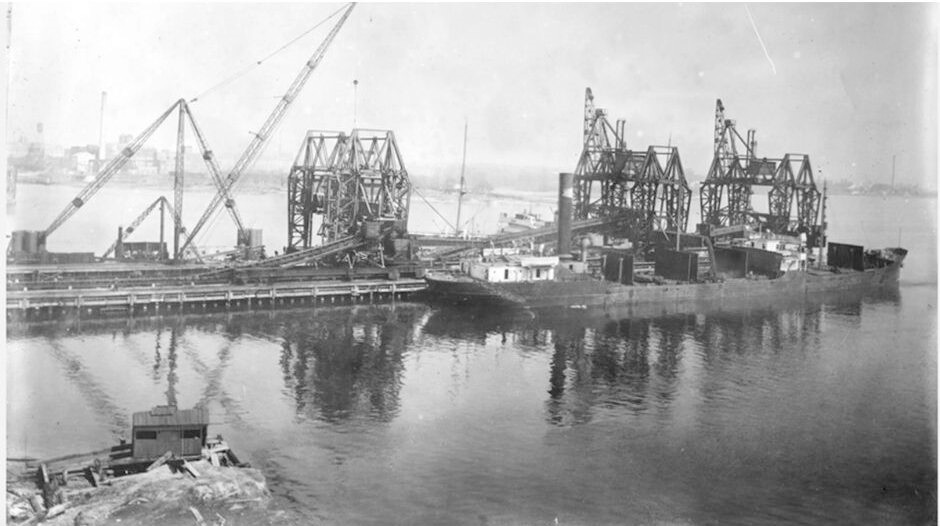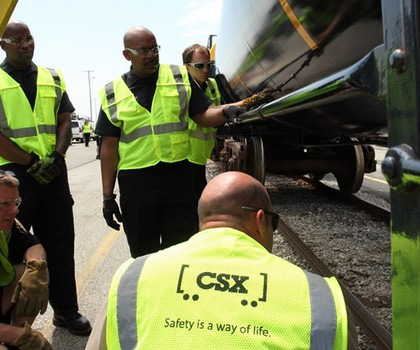- Coal has been handled in the Baltimore, MD area for over 200 years. It was originally handled in the inner harbor and moved to Curtis Bay 100 years ago.
- Curtis Bay Piers is strategically located on the CSX network and the Chesapeake Bay. It primarily handles coal from the Northern Appalachian coal region (NAPP) but has also successfully handled coal from other regions, including Central Appalachian (CAPP), Illinois Basin (ILB), Southern Appalachian (SAPP), Colorado and Powder River Basins (PRB).
- Read more HERE.
- A Fugitive Dust Plan is used to mitigate dust on site. This plan includes continuous monitoring of weather conditions and an automated water spray system that operates when wind speeds warrant. Water sprays are located around the perimeter of all storage piles and at the top of each transfer tower.
- CSX captures 100% of storm water and all water that comes in contact with coal operations. That water is reused onsite for water spraying and dust suppression. This onsite water reuse saves gallons every year and prevents discharge to the city and the bay.
- A water spray truck is used onsite to control dust on the roadways and parking lots.
- All employees and vendors are trained to observe for dust and emissions. Daily safety and operations meeting discuss potential weather conditions and plans for dust mitigation. If emissions are observed, the event is communicated with onsite supervisors. Operations are halted to correct the emissions, or the water sprayers are manually activated.
- CSX is deeply committed to safe and environmentally sound operations at all of our facilities. The Curtis Bay facility has been operating for over 140 years without an incident like the one that occurred in 2021, which fortunately did not result in any injuries. Since the incident, CSX has improved airflow and conducts constant monitoring in the tunnels while continuing to work with industry experts and regulatory agencies to ensure that an incident of this nature never happens again. Investments have been made to advance long-term operational safety, improve dust control and collect 100% of storm water for onsite reuse at our facility. We remain committed to the safety and health of our employees and our neighboring communities.
- A fully operational Curtis Bay Piers facility employs nearly 700 Marylanders, supports an overall port system of nearly 140,000 jobs, generates about $335 million in economic value for the state, and contributes $21.1M in state and local tax revenue as a result of the activity that occurs there. This makes it an essential part of the Port of Baltimore and state of Maryland.
- In addition, as the second largest exporter of coal in the country, the Port of Baltimore relies on the coal volume moving through the CSX’s Curtis Bay Piers to access $20 million annually in federal dredging dollars, supporting the growth at Seagirt Marine Terminal and Tradepoint Atlantic. Without the Curtis Bay facility at full operation, the Port of Baltimore could lose vital federal funding that supports many well-paying jobs across the region.
- A grant through the Federal Railroad Administration’s Consolidated Rail Infrastructure and Safety Improvements (CRISI) program will enable CSX to use battery electric locomotives in the Curtis Bay terminal to advance sustainability efforts at the Port of Baltimore. This will replace three, older diesel-electric switching locomotives with three, new battery-electric locomotives and add a battery charging station. This will introduce the first ever zero-exhaust emissions locomotives at an east coast port, benefiting port employees, shippers, and the local community by reducing air emissions and noise. CSX is providing a 50 percent non-Federal match and look forward to working together with federal, state, and local agencies, to advance this important project, fostering sustainable transportation solutions and enhanced connectivity for all.
- CSX’s air quality permit to construct issued on September 7, 2022 required CSX to submit a fence line monitoring plan to the Maryland Department of the Environment describing the installation, operation, and maintenance of a network of PM10 and PM2.5 monitors along the facility’s perimeter and a weather station. Pursuant to the Permit to Construct and the fence line monitoring plan, CSX was required to install one FEM monitor to measure both PM10 and PM2.5, install multiple sensors capable of measuring PM10 and PM2.5, and operate a 10-meter meteorological tower that meets current U.S. EPA protocols and guidance. Equipment installation began in Spring 2023.


For more frequently asked questions and answers: https://www.csx.com/index.cfm/customers/resources/faqs/
